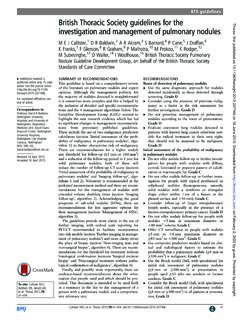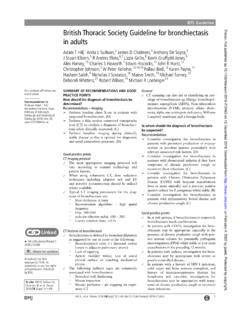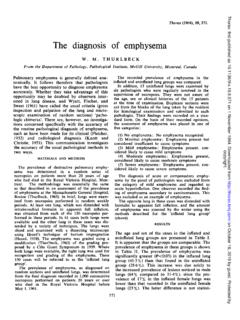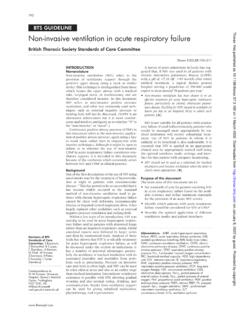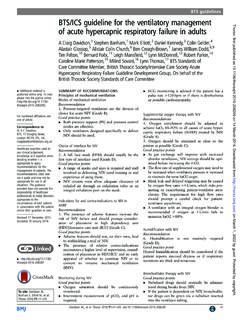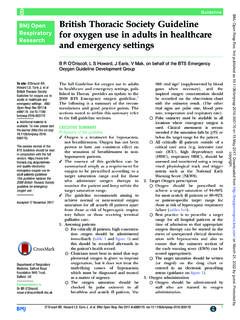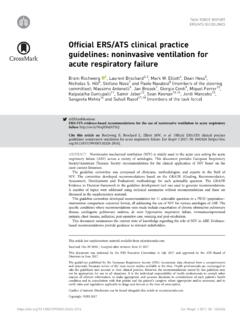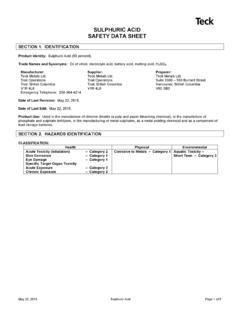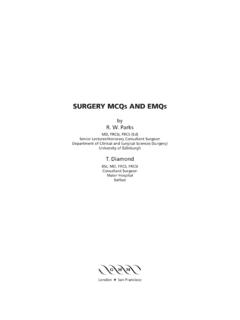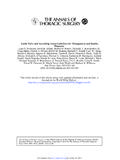Transcription of BTS guideline for oxygen use in adults in healthcare and ...
1 BTS guideline BTS guideline for oxygen use in adults in healthcare Thorax: first published as on 15 May 2017. Downloaded from on March 31, 2022 by guest. Protected by copyright. and emergency settings B R O'Driscoll,1,2 L S Howard,3 J Earis,4 V Mak,5 on behalf of the british thoracic Society emergency oxygen guideline Group Additional material is EXECUTIVE SUMMARY OF THE guideline appropriate oxygen therapy can be started in the published online only. To view Philosophy of the guideline event of unexpected clinical deterioration with please visit the journal online ( oxygen is a treatment for hypoxaemia, not hypoxaemia and also to ensure that the oxim- thoraxjnl-2016-209729). breathlessness. oxygen has not been proven to etry section of the early warning score (EWS). 1 have any consistent effect on the sensation of can be scored appropriately. Respiratory Medicine, Salford Royal Foundation NHS Trust, breathlessness in non-hypoxaemic patients. The target saturation should be written (or Salford, UK The essence of this guideline can be summarised ringed) on the drug chart or entered in an elec- 2.
2 Manchester Academic Health simply as a requirement for oxygen to be prescribed tronic prescribing system (guidance on gure 1. Sciences Centre (MAHSC), according to a target saturation range and for those (chart 1)). Manchester, UK. 3. Hammersmith Hospital, who administer oxygen therapy to monitor the Imperial College healthcare patient and keep within the target saturation range. 3 oxygen administration NHS Trust, London, UK The guideline recommends aiming to achieve oxygen should be administered by staff who are 4. University of Liverpool, normal or near-normal oxygen saturation for all trained in oxygen administration. Liverpool, UK. 5 acutely ill patients apart from those at risk of These staff should use appropriate devices and Imperial College healthcare NHS Trust, London, UK hypercapnic respiratory failure or those receiv- ow rates in order to achieve the target saturation ing terminal palliative care. range ( gure 2 (chart 2)). Correspondence to Staff should be trained in the use of a range of Dr BR O'Driscoll, Respiratory 1 Assessing patients different oxygen delivery devices to ensure Medicine, Level 4 Brooke For critically ill patients, high-concentration Building (Orange Area), Salford oxygen is delivered safely.
3 oxygen should be administered immediately Royal Foundation NHS Trust, (table 1 and gure 1 (chart 1)) and this should Stott Lane, Salford M6 8HD, UK; @ be recorded afterwards in the patient's health 4 Monitoring and maintenance of target uk record. saturation Clinicians must bear in mind that supplemental Received 15 November 2016 oxygen saturation and delivery system (includ- oxygen is given to improve oxygenation but it Revised 3 February 2017 ing ow rate) should be recorded on the does not treat the underlying causes of hypox- Accepted 12 February 2017 patient's monitoring chart. aemia which must be diagnosed and treated as a oxygen delivery devices and ow rates should matter of urgency. be adjusted to keep the oxygen saturation in the The oxygen saturation should be checked by target range. Prompt clinical assessment is pulse oximetry in all breathless and acutely ill required if oxygen therapy needs to be initiated patients, the fth vital sign' (supplemented by or increased due to a falling saturation level.)
4 Blood gases when necessary) and the inspired oxygen should be prescribed and a signature oxygen concentration should be recorded on the should be entered on the drug chart on each observation chart with the oximetry result. (The drug round. other vital signs are pulse rate, blood pressure, temperature and respiratory rate). Pulse oximetry must be available in all locations 5 Weaning and discontinuation of oxygen where emergency oxygen is used. Clinical assess- therapy ment is recommended if the saturation falls by oxygen should be reduced in stable patients 3% or below the target range for the patient. with satisfactory oxygen saturation. All critically ill patients outside of a critical care oxygen should be discontinued once the patient area (eg, intensive care unit (ICU), high depend- can maintain saturation within or above the ency unit (HDU), respiratory HDU) should be target range breathing air but the prescription assessed and monitored using a recognised for a target range should be left in place in case thoraxjnl-2017-209951 physiological track and trigger system such as of future deterioration and to guide EWS/.
5 The National Early Warning Score (NEWS). NEWS. bmjresp-2016-000170. 2 Target oxygen prescription 3 SUMMARY OF guideline . oxygen should be prescribed to achieve a target RECOMMENDATIONS AND GOOD PRACTICE. saturation of 94 98% for most acutely ill POINTS. patients or 88 92% or patient-speci c target A Achieving desirable oxygen saturation ranges range for those at risk of hypercapnic respira- in acute illness (see sections 6 and 8 and To cite: O'Driscoll BR, tory failure (tables 1 4). gures 1 2). Howard LS, Earis J, et al. Best practice is to prescribe a target range for all A1: This guideline recommends aiming to achieve a Thorax 2017;72:i1 i90. hospital patients at the time of admission so that normal or near-normal oxygen saturation for all O'Driscoll BR, et al. Thorax 2017;72:i1 i90. i1. BTS guideline Table 1 Critical illness requiring high levels of supplemental oxygen Thorax: first published as on 15 May 2017. Downloaded from on March 31, 2022 by guest.
6 Protected by copyright. Section The initial oxygen therapy is a reservoir mask at 15 L/min pending the availability of reliable oximetry readings. For patients with spontaneous circulation and a reliable oximetry reading, it may quickly become possible to reduce the oxygen dose while maintaining a target saturation range of 94 98%. If oximetry is unavailable, continue to use a reservoir mask until definitive treatment is available. Patients with COPD and other risk factors for hypercapnia who develop critical illness should have the same initial target saturations as other critically ill patients pending the results of blood gas results after which these patients may need controlled oxygen therapy with target range 88 92% or supported ventilation if there is severe hypoxaemia and/or hypercapnia with respiratory acidosis. Additional comments Recommendations Cardiac arrest or resuscitation Refer to resuscitation guidelines for choice of delivery device during active resuscitation.
7 Recommendation E1. Give highest possible inspired oxygen concentration during CPR until spontaneous circulation has been restored. Shock, sepsis, major trauma, drowning, anaphylaxis, Also give specific treatment for the underlying condition Recommendations major pulmonary haemorrhage, status epilepticus E2 E4. Major head injury Early tracheal intubation and ventilation if comatose Recommendation E5. Carbon monoxide poisoning Give as much oxygen as possible using a bag-valve mask or reservoir mask. Check Recommendation E6. carboxyhaemoglobin levels. A normal or high oximetry reading should be disregarded because saturation monitors cannot differentiate between carboxyhaemoglobin and oxyhaemoglobin, owing to their similar absorbances. The blood gas PO2 will also be normal in these cases (despite the presence of tissue hypoxia). COPD, chronic obstructive pulmonary disease; CPR, cardiopulmonary resuscitation; PO2, oxygen tension arterial or arterialised blood gases.
8 Acutely ill patients apart from those at risk of hypercapnic B2: oxygen saturation, the fth vital sign', should be respiratory failure (grade D). checked by trained staff using pulse oximetry in all breathless A2: The recommended target saturation range for acutely ill and acutely ill patients (supplemented by blood gases when patients not at risk of hypercapnic respiratory failure is 94 98% necessary) and the inspired oxygen device and ow rate should (grade D). be recorded on the observation chart with the oximetry result A3: For most patients with known chronic obstructive pul- (grade D). monary disease (COPD) or other known risk factors for hyper- B3: Initial clinical assessment and subsequent monitoring of capnic respiratory failure (eg, morbid obesity, cystic brosis acutely unwell patients should include the use of a recognised (CF), chest wall deformities or neuromuscular disorders or xed physiological track and trigger' system, such as the NEWS.)
9 Air ow obstruction associated with bronchiectasis), a target sat- which may trigger clinical review due to hypoxaemia, need for uration range of 88 92% is suggested pending the availability of supplementary oxygen or for other reasons (grade D). blood gas results (grade A for COPD, grade D for other B4: For patients who are at risk of hypercapnic respiratory conditions). failure, it is recommended that the relevant section of the 2017. A4: Most non-hypoxaemic breathless patients do not bene t NEWS chart should be used. Points are awarded if the oxygen from oxygen therapy, but a sudden reduction of 3% in a saturation is below or above the target range (grade D). patient's oxygen saturation within the target saturation range Good practice points for clinical assessment of patients with sus- should prompt fuller assessment of the patient (and the oxim- pected hypoxaemia eter signal) because this may be the rst evidence of an acute The medical history should be taken when possible in an illness (grade D).
10 Acutely breathless patient and may point to the diagnosis of a A5: Since oxygenation is reduced in the supine position, fully particular acute illness such as pneumonia or pulmonary conscious hypoxaemic patients should ideally be allowed to embolism or an exacerbation of a chronic condition such as maintain the most upright posture possible (or the most com- COPD, asthma or heart failure. fortable posture for the patient) unless there are good reasons to Never discontinue oxygen therapy to obtain an oximetry immobilise the patient (eg, skeletal or spinal trauma) (grade D). measurement on room air in patients who clearly require oxygen therapy. B Clinical and laboratory assessment of hypoxaemia and Physical examination should be undertaken urgently. hypercapnia This may provide evidence of a speci c diagnosis such as B1: Fully trained clinicians should assess all acutely ill patients heart failure or a large pleural effusion, but it is by measuring respiratory rate, pulse rate, blood pressure and common for the cause of breathlessness to remain temperature and assessing circulating blood volume and undiagnosed until the results of tests such as chest radio- anaemia (see section 7).
